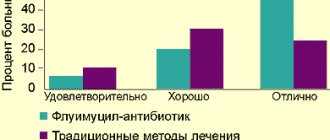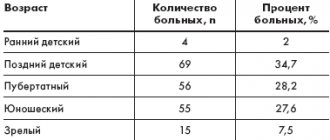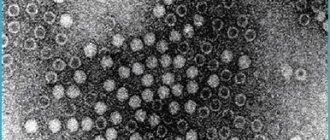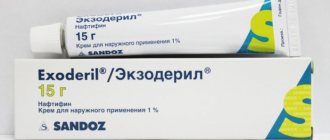Preparations with interferon: forms and contents
Modern pharmacology offers a huge selection of interferon-based drugs. They vary in dosage form, they can be: rectal suppositories, drops, gels, ointments, sprays, injection solutions and so on. They are no less diverse in composition: not all drugs are the same; they can often differ in the presence of auxiliary components, as well as in the dosage of the active substance. They have only one thing in common - the active substance itself, that is, interferon alpha-2b1, which is responsible in our body for fighting viruses and bacteria. This is a natural protein that is produced by the body in response to an infectious attack. It helps block the virus and protect healthy cells from infection, and also has a number of indirect antibacterial effects. Preparations containing this substance have been well studied and have been used for more than 50 years. Its main feature is a wide spectrum of antiviral activity, which allows doctors to use interferon-based drugs to treat various infectious and inflammatory diseases.
Ointments with interferon: scope of application
These drugs are external, that is, drugs that are applied to the skin or mucous membrane. The effect of such a drug occurs on a limited surface, where it is applied. In other words, this dosage form is a local therapy drug. Like any medicine, interferon-based ointment is included in the register of medicines. The drugs included in the register have undergone the full range of studies and are approved by the Russian Ministry of Health for medical use. In what cases do doctors prescribe ointments containing this protein? As a rule, in cases where viruses of various origins are localized on human skin, creating a rash, neoplasms and other, including cosmetic, skin defects:
- herpetic infection,
- warts,
- papillomavirus,
- condylomas and so on.
To relieve the severity of inflammation and to prevent further spread of infection, as well as to fight viruses, it is recommended to apply the drug to the affected areas. How to choose the right medicine? When considering certain medications based on interferon, you need to pay attention to the dosage of the active substance in IU so that it corresponds to the dosage prescribed by the doctor, and, in addition, carefully read the instructions, especially the section that indicates age or other contraindications and restrictions for patients . It is worth paying attention to what is included in the drug, except for interferon. For example, one of the components of the drug VIFERON Ointment is peach oil. The composition of peach seed oil is surprisingly balanced. This is one of the rare oils, almost 40% of the vitamin content in which is vitamins PP and A, supplemented with ascorbic acid and vitamins E and B. Almost two-thirds of the fatty acid composition is oleic acid, another third is linoleic acid. These acids have wound healing and moisturizing properties. Peach oil has also been found to have antioxidant properties, which are known to help relieve symptoms of inflammation.
It must be remembered that there are medications that cannot be taken during pregnancy or breastfeeding, and there are also medications that are not recommended for children under a certain age. But there are others, for example, VIFERON Ointment, which are allowed for children from one year old, as well as for pregnant and lactating women.
Interferon ointment: instructions for use
Let's consider how and in what cases you can use products with the active ingredient interferon using the example of the drug VIFERON Ointment. This drug has a minimal number of contraindications. According to the instructions, it can be used by pregnant women regardless of the stage of pregnancy; it is also suitable for children over 1 year of age.
Let's consider some cases when this remedy is prescribed. Any interferon ointment has instructions for use, which you should read before using the drug.
Flu and ARVI
External agents with interferon can be recommended by doctors not only for treatment, but also for prevention. In the treatment of ARVI and influenza, VIFERON ointment is used as part of complex therapy. It is recommended, including for pregnant women, regardless of gestation week, nursing mothers, children and the elderly. Before applying, you must clean the nasal passages. Apply three times a day. For the prevention and treatment of influenza and other acute respiratory viral infections, you can use VIFERON in the form of a gel (2 times a day every 12 hours).
Herpes
This is a viral infection that seriously affects the patient's quality of life. Regular ulcerative rashes on various parts of the body cause cosmetic defects and lead to physical discomfort. Unfortunately, medicine cannot yet completely cure a person from the herpes virus. Once it enters the host’s body, herpes settles in the nerve cells and remains there until the end of the person’s life. Rashes occur when the patient, for one reason or another, weakens the immune system, which is no longer able to contain the multiplication of the virus.
And then bubbles with clear liquid appear at the nerve endings on the skin or mucous membrane. Doctors also recommend a systemic approach to the treatment of herpes4.
Ointments help block the proliferation of viruses at the source of infection; timely treatment helps to avoid the appearance of scars and other cosmetic blemishes at the site of herpetic eruptions. It is better to apply the product as soon as the first symptoms of the rash appear - itching, burning, redness. Apply VIFERON Ointment to the affected area three to four times a day for 5-7 days. For more severe cases of the disease, including frequent recurrences of the disease, an integrated approach is recommended: systemic therapy is added to external therapy, that is, with the drug VIFERON Suppositories.
Papillomas
The instructions for use of the drug VIFERON Ointment do not currently indicate papillomavirus infection. For the treatment of diseases caused by the human papillomavirus, the drug VIFERON Rectal Suppositories can be used. The recommended dose for adults is VIFERON® 500,000 IU, 1 suppository 2 times a day every 12 hours every day for 5-10 days. According to clinical indications, therapy can be continued.
References
- Lifshits, V.M., Sidelnikova, V.I. Medical laboratory tests. - M.: Triad X, 2007. - 312 p.
- Nesterova, I.V. Congenital and acquired interferonopathies: differentiated approaches to interferon-corrective therapy, Federal State Autonomous Educational Institution of Higher Education "Russian Peoples' Friendship University" of the Ministry of Education and Science of the Russian Federation, Moscow, 2021. - V. 16(2). — P. 50-53.
- Savenkova, M.S., Karashtina, O.V., Shabat, M.B. and others. Interferon status and choice of interferon inducers in frequently ill children. - Children's infections, 2021. - No. 2. - P. 45-51.
Interferon ointment for children instructions for use
VIFERON ointment can be used to treat children over 1 year of age.
Herpes infection in young children.
For babies after one year of age, it is recommended to apply the drug to the affected areas 3-4 times a day for a course of 5 to 7 days. The drug can be used for all types of herpetic eruptions of various locations. And children under one year old can use VIFERON Gel.
In the treatment of influenza and ARVI
In children, as part of complex therapy, the ointment is prescribed:
- From 1 year to 2 years: dosage 2500 IU (1 pea with a diameter of 0.5 cm) is applied in a thin layer to the mucous membrane of the nasal passages 3 times a day, course 5 days;
- From 2 years to 12 years: a dosage of 2500 IU (1 pea with a diameter of 0.5 cm) is applied in a thin layer to the mucous membrane of the nasal passages 4 times a day, a course of 5 days;
- From 12 to 18 years: a dosage of 5000 IU (1 pea with a diameter of 1 cm) is applied in a thin layer to the mucous membrane of the nasal passages 4 times a day, a course of 5 days.
To prevent colds, VIFERON Gel is used, as mentioned above. During the period of rising incidence, a strip of gel no more than 0.5 cm long is applied to the previously dried surface of the nasal mucosa and/or to the surface of the tonsils 2 times a day for 2-4 weeks.
Reference and information material
Author of the article
Gerasimenko Igor Olegovich
General Practitioner
Sources:
- 1. https://humbio.ru
- 2. State register of medicines
- 3. https://www.sciencedirect.com
- 4. https://www.who.int
Loading...
Take other surveys
Altevir (Interferon alfa-2b) solution for injection, 5 million IU/ml amp 1 ml N5
Registration Certificate Holder
PHARMAPARK (Russia)
Dosage form
Medicine - Altevir® (Altevir)
Description
Injection
transparent, colorless.
1 ml
human recombinant interferon alpha-2b 3 million IU
Excipients
: sodium acetate, sodium chloride, ethylenediaminetetraacetic acid disodium salt, Tween-80, dextran 40, water for injection.
1 ml - ampoules (5) - contour cell packaging (1) - cardboard packs. 1 ml - ampoules (5) - contour cell packaging (2) - cardboard packs. 1 ml - bottles (1) - cardboard packs. 1 ml - bottles (5) - contour cell packaging (1) - cardboard packs. 1 ml - glass syringes (1) - contour cell packaging (1) - cardboard packs. 1 ml - glass syringes (1) - contour cell packaging (3) - cardboard packs. 1 ml - glass syringes (3) - contour cell packaging (1) - cardboard packs. 1 ml - glass syringes (3) - contour cell packaging (3) - cardboard packs.
Indications
As part of complex therapy in adults:
- with chronic viral hepatitis B without signs of liver cirrhosis;
- for chronic viral hepatitis C in the absence of symptoms of liver failure (monotherapy or combination therapy with ribavirin);
- with papillomatosis of the larynx;
- for genital warts;
- for hairy cell leukemia, chronic myeloid leukemia, non-Hodgkin's lymphoma, melanoma, multiple myeloma, Kaposi's sarcoma against the background of AIDS, progressive kidney cancer.
Contraindications for use
- history of severe cardiovascular disease (uncontrolled chronic heart failure, recent myocardial infarction, severe heart rhythm disturbances);
- severe renal and/or liver failure (including those caused by the presence of metastases);
- epilepsy, as well as severe dysfunction of the central nervous system, especially expressed by depression, suicidal thoughts and attempts (including a history);
- chronic hepatitis with decompensated liver cirrhosis and in patients receiving or recently receiving treatment with immunosuppressants (with the exception of completed short-term treatment with corticosteroids);
- autoimmune hepatitis or other autoimmune disease;
- treatment with immunosuppressants after transplantation;
- thyroid disease that cannot be controlled by conventional therapeutic methods;
- decompensated lung diseases (including COPD);
- decompensated diabetes mellitus;
- hypercoagulation (including thrombophlebitis, pulmonary embolism);
- severe myelodepression;
- pregnancy;
- lactation period (breastfeeding);
- hypersensitivity to the components of the drug.
pharmachologic effect
Interferon. Altevir® has antiviral, immunomodulatory, antiproliferative and antitumor effects.
Interferon alpha-2b, interacting with specific receptors on the cell surface, initiates a complex chain of changes inside the cell, including the induction of the synthesis of a number of specific cytokines and enzymes, and disrupts the synthesis of viral RNA and viral proteins in the cell. The result of these changes is nonspecific antiviral and antiproliferative activity associated with the prevention of viral replication in the cell, inhibition of cell proliferation and the immunomodulatory effect of interferon. Interferon alpha-2b stimulates the process of antigen presentation to immunocompetent cells, has the ability to stimulate the phagocytic activity of macrophages, as well as the cytotoxic activity of T cells and “natural killer” cells involved in antiviral immunity.
Prevents cell proliferation, especially tumor cells. It has an inhibitory effect on the synthesis of some oncogenes, leading to inhibition of tumor growth.
Drug interactions
Drug interactions between Altevir and other drugs have not been fully studied. Altevir® should be used with caution simultaneously with hypnotics and sedatives, narcotic analgesics and drugs that potentially have a myelosuppressive effect.
When Altevir and theophylline are prescribed simultaneously, the concentration of the latter in the blood serum should be monitored and, if necessary, its dosage regimen should be changed.
When Altevir is used in combination with chemotherapeutic drugs (cytarabine, cyclophosphamide, doxorubicin, teniposide), the risk of developing toxic effects increases.
Dosage regimen
Apply subcutaneously, intramuscularly and intravenously. Treatment must be started by a doctor. Then, with the doctor’s permission, the patient can administer a maintenance dose independently (in cases where the drug is prescribed subcutaneously or intramuscularly).
Chronic hepatitis B:
Altevir® is administered subcutaneously or intramuscularly at a dose of 5-10 million IU 3 times a week for 16-24 weeks. Treatment is stopped after 3-4 months of use in the absence of positive dynamics (according to a study of hepatitis B virus DNA).
Chronic hepatitis C:
Altevir® is administered subcutaneously or intramuscularly at a dose of 3 million IU 3 times a week for 24-48 weeks. In patients with a relapsing course of the disease and patients who have not previously received treatment with interferon alfa-2b, the effectiveness of treatment increases with combination therapy with ribavirin. The duration of combination therapy is at least 24 weeks. Therapy with Altevir should be carried out for 48 weeks in patients with chronic hepatitis C and the 1st genotype of the virus with a high viral load, in whom hepatitis C virus RNA is not detected in the blood serum by the end of the first 24 weeks of treatment.
Laryngeal papillomatosis:
Altevir® is administered subcutaneously at a dose of 3 million IU/m2 3 times a week. Treatment begins after surgical (or laser) removal of the tumor tissue. The dose is selected taking into account the tolerability of the drug. Achieving a positive response may require treatment for 6 months.
Hairy cell leukemia:
The recommended dose of Altevir for subcutaneous administration to patients after or without splenectomy is 2 million IU/m2 3 times a week. In most cases, normalization of one or more hematological parameters occurs after 1-2 months of treatment; it is possible to increase the treatment period to 6 months. This dosage regimen should be followed continuously unless rapid progression of the disease or symptoms of severe intolerance to the drug occur.
Chronic myeloid leukemia:
The recommended dose of Altevir as monotherapy is 4-5 million IU/m2 per day subcutaneously daily. To maintain the number of leukocytes, a dose of 0.5-10 million IU/m2 may be required. If treatment allows to achieve control of the number of leukocytes, then to maintain hematological remission the drug should be used at the maximum tolerated dose (4-10 million IU/m2 daily). The drug should be discontinued after 8-12 weeks if therapy does not lead to partial hematological remission or a clinically significant decrease in the number of leukocytes.
Non-Hodgkin's lymphoma:
Altevir® is used as adjuvant therapy in combination with standard chemotherapy regimens. The drug is administered subcutaneously at a dose of 5 million IU/m2 3 times a week for 2-3 months. The dose must be adjusted depending on the tolerability of the drug.
Melanoma:
Altevir® is used as adjuvant therapy in adults with a high risk of relapse after tumor removal. Altevir® is administered intravenously at a dose of 15 million IU/m2 5 times a week for 4 weeks, then subcutaneously at a dose of 10 million IU/m2 3 times a week for 48 weeks. The dose must be adjusted depending on the tolerability of the drug.
Multiple myeloma
: Altevir® is prescribed during the period of achieving stable remission at a dose of 3 million IU/m2 3 times a week subcutaneously.
Kaposi's sarcoma due to AIDS:
the optimal dose has not been established. The drug can be used in doses of 10-12 million IU/m2/day subcutaneously or intramuscularly. If the disease stabilizes or responds to treatment, therapy is continued until tumor regression occurs or drug discontinuation is required.
Kidney cancer:
The optimal dose and regimen have not been established.
It is recommended to use the drug subcutaneously in doses of 3 to 10 million IU/m2 3 times a week. Preparation of a solution for intravenous administration:
Draw up the volume of Altevir solution required to prepare the required dose, add it to 100 ml of a sterile 0.9% sodium chloride solution and administer it over 20 minutes.
Overdose
Data on overdose of Altevir® are not provided.
Side effect
General reactions:
very often - fever, weakness (they are dose-dependent and reversible reactions, disappear within 72 hours after a break in treatment or its cessation), chills; less often - malaise.
From the side of the central nervous system:
very often - headache; less often - asthenia, drowsiness, dizziness, irritability, insomnia, depression, suicidal thoughts and attempts; rarely - nervousness, anxiety.
From the musculoskeletal system:
very often - myalgia; less often - arthralgia.
From the digestive system:
very often - loss of appetite, nausea; less often - vomiting, diarrhea, dry mouth, change in taste; rarely - abdominal pain, dyspepsia; a reversible increase in liver enzyme activity is possible.
From the cardiovascular system:
often - decreased blood pressure; rarely - tachycardia.
Dermatological reactions:
less often - alopecia, increased sweating;
rarely - skin rash, itching. From the hematopoietic system
: reversible leukopenia, granulocytopenia, decreased hemoglobin levels, thrombocytopenia are possible.
Other:
rarely - weight loss, autoimmune thyroiditis.
special instructions
Before treatment with Altevir for chronic viral hepatitis B and C, it is recommended to perform a liver biopsy to assess the degree of liver damage (signs of active inflammatory process and/or fibrosis). The effectiveness of treatment of chronic hepatitis C increases with combination therapy with Altevir and ribavirin. The use of Altevir is not effective in the development of decompensated liver cirrhosis or hepatic coma.
If side effects occur during treatment with Altevir, the dose of the drug should be reduced by 50% or the drug should be temporarily discontinued until they disappear. If side effects persist or recur after dose reduction, or disease progression is observed, treatment with Altevir should be discontinued.
If the platelet level decreases below 50×109/l or the granulocyte level below 0.75×109/l, it is recommended to reduce the Altevir dose by 2 times with blood test monitoring after 1 week. If these changes persist, the drug should be discontinued.
If the platelet level decreases below 25x109/l or the granulocyte level below 0.5x109/l, it is recommended to discontinue Altevir® with blood test monitoring after 1 week.
In patients receiving interferon alpha-2b preparations, antibodies that neutralize its antiviral activity can be detected in the blood serum. In almost all cases, antibody titers are low, their appearance does not lead to a decrease in the effectiveness of treatment or the occurrence of other autoimmune disorders.
Storage conditions
The drug should be stored out of the reach of children, in accordance with SP 3.3.2-1248-03 at a temperature of 2° to 8°C; do not freeze.
Best before date
Shelf life: 18 months.
Transport at temperatures from 2° to 8°C; do not freeze.
Use during pregnancy and breastfeeding
Restrictions during pregnancy - Contraindicated. Restrictions when breastfeeding - Contraindicated.
The drug is contraindicated during pregnancy and lactation (breastfeeding).
Use for renal impairment
Restrictions for impaired renal function - With caution.
The drug is contraindicated in severe renal and/or liver failure (including those caused by the presence of metastases).
Use for liver dysfunction
Restrictions for liver dysfunction - With caution.
The drug is contraindicated in severe renal and/or liver failure (including those caused by the presence of metastases).
Terms of sale
The drug is available with a prescription.
Contacts for inquiries
PHARMSTANDARD JSC (Russia)
141701 Moscow region. Dolgoprudny, Likhachevsky pr-d, 5B Tel./fax E-mail







